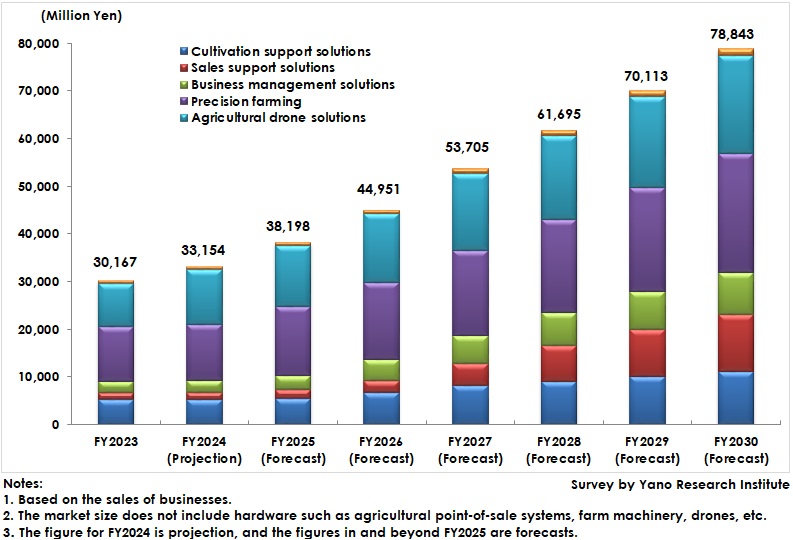No.3740
Smart Agriculture Market in Japan: Key Research Findings 2024
Smart Agriculture Market Size in Japan Expected to Reach 33.1 Billion Yen by FY2024
Yano Research Institute (the President, Takashi Mizukoshi) has surveyed the smart agriculture market in Japan and found out the market size, trend of market players, and future outlook.

Market Overview
The smart agriculture market in Japan is estimated to grow to 33,154 million yen in FY2024, 109.9% of the size of the previous fiscal year, based on the sales at enterprises.
Smart rice planting systems, which are available for variable fertilization and can reduce fertilizer application in the situation of soaring chemical fertilizer prices, and remote sensing systems, which can create a crop growth map to detect changes in the cultivation environment, continued to proliferate in FY2024.
The carrying capacity of drones has become colossal, which is increasing the number of farmers using drones for remote sensing of farmland to regulate fertilizer applications. The penetration of fertilizer applications that are aligned with a crop growth map enables pinpoint application of fertilizer only to non-growing crops. This not only eliminates unbalanced crop growth but also reduces excess fertilizer application and labor.
Noteworthy Topics
Smart Agriculture Expected to Proliferate Following the Enactment of the Law to Promote the Utilization of Smart Agricultural Technology in October 2024
The Act on Promoting the Utilization of Smart Agricultural Technology was enacted in October 2024, with the aim of promoting the use of smart agriculture on-site among a wide range of people. The Act encourages a shift from habitual manual-based production processes to production using smart agricultural technology at agricultural production sites.
As the Act also aims to support and expand agricultural contracting services that use smart agriculture or new distribution/sales methods used by food service providers that procure agricultural products, the smart agricultural technology is expected to spread beyond agricultural producers, which may lead to local employment and the creation of new business models.
Future Outlook
The smart agricultural market in Japan is forecast to expand to 78,843 million yen by FY2030.
In the future, agricultural delivery planning can be created by predicting the appropriate harvesting period for each region through the crop growth information of each farmland collected by smart agricultural technology (satellite, drone, smart agricultural machinery, sensors, etc.) For example, new agricultural ICT services may be available such as delivery planning by relaying through production areas according to customer demand, aiming to eliminate waste or shipment losses, or the sharing service of robotic agricultural machinery, agricultural drones, agricultural robots, etc.
According to the Ministry of Agriculture, Forestry, and Fisheries, the core population engaged in agriculture is expected to decline to one-fourth in the next two decades. Therefore, it is impossible to ensure sustainable agricultural development or stable food supply if traditional agricultural production continues. In the rapidly shrinking agricultural population, the technology to improve production per farmland area or per labor hour is essential, and it is necessary to popularize smart agriculture to solve these problems.
Research Outline
2.Research Object: Companies entered in smart agriculture business, agricultural corporations (paddy rice cultivation, agriculture & horticulture [vegetables, fruits, and flowers]), related organizations, associations, and the concerned government agencies
3.Research Methogology: Face-to-face interviews (including online interviews) by our expert researchers, surveys via telephone & email, and literature search
About Smart Agriculture
Smart agriculture in this research refers to the concept of combining conventional agricultural techniques with telecommunication technologies to further increase production efficiency and add value to the produce. It aims to achieve high agricultural productivity, cost reduction, food safety and a safe working environment by deploying telecommunication technologies throughout production to harvest/sale process.
The target market areas are as follows: 1) cultivation support solution, 2) sales support solution, 3) business management solution, 4) precision farming, 5) agricultural drone solution, and 6) agricultural robots.
Note that the research only includes the market in Japan, and the market size is calculated based on the sales at businesses. The market size does not include hardware such as agricultural point-of-sale systems, farm machinery, drones, etc.
<Products and Services in the Market>
1) Cultivation support solutions (cloud-based farming, compound environmental control equipment, and smart water management systems for arable land), 2) Sales support solutions (ICT systems to facilitate the business workflow for client companies (food service companies, JA) of the produce, sales support services utilizing weather data, and other solutions), 3) Business management solutions (agricultural accounting software, accounting support services for agricultural corporations, business management services using weather data, etc.) 4) Precision farming (GPS guidance systems and robotic farming machines [smart rice planting systems, robotic tractors], satellite-information-using systems, and other solutions), 5) Agricultural drone solutions (agrochemical spraying services using drones, sensing for arable lands, etc., but does not include drones as the hardware), and 6) Agricultural robots (facility robots [grafting robots, etc.,] manipulator robots [harvesting robots, etc.,] assisting robots [powered suits/exoskeletons, etc.])
Published Report
Contact Us
The copyright and all other rights pertaining to this report belong to Yano Research Institute.
Please contact our PR team when quoting the report contents for the purpose other than media coverage.
Depending on the purpose of using our report, we may ask you to present your sentences for confirmation beforehand.